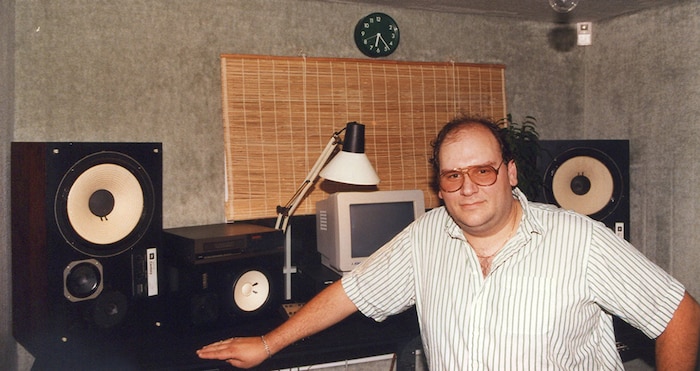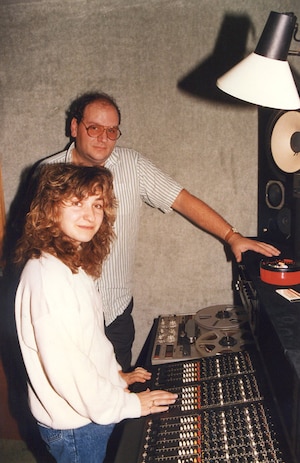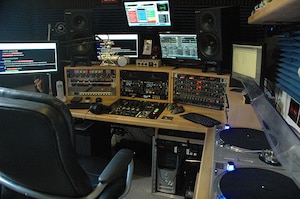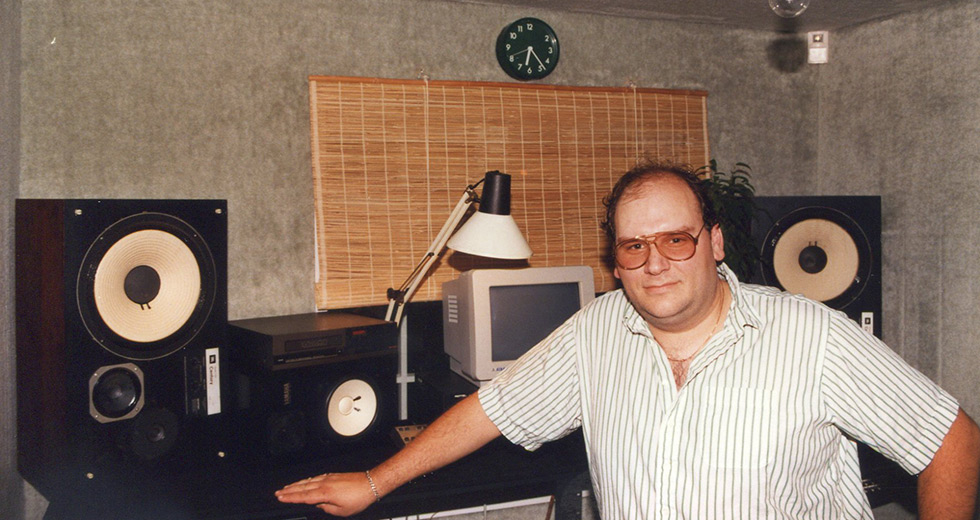Key Tracks: Les Adams on the K&T remix of Maurice’s “This Is Acid”
The UK architect behind the famous Chicago house remix reveals how it was made.

There are some instances where a remix becomes the best known version of a song. Case-in-point: The 1988 K&T remix of Maurice’s “This Is Acid.” The original mix was barely noticed around the time of its creation, while the blue and pink labels with the Vendetta Records zipper logo are unmistakable. The man behind these versions was UK DMC DJ Les Adams, who also often produced and remixed under the L.A. Mix moniker. He worked with many major labels and emerging dance music artists, beginning in 1985 with a remix of The Brothers Johnson’s “Stomp” which led to working with artists like Aretha Franklin and Inner City. Adams was born and raised in Worcester Park, Surrey. Many years and productions later, he has returned – a mile from his original home. Instead of producing/remixing from his home studio, he now runs a radio show, Les Adams’ Dancefloor Classics.
Did you grow up playing music and DJing? How did you start producing electronic music? What got you into it?
Music was a huge part of growing up for me. Even at school I was the child responsible for putting on the records at morning assembly. As a young boy I listened to the ’60s offshore pirate radio ships. My favourite was Radio London, “Big L” as it was known. Along with Radio Caroline and others of its type, in three short years they changed radio in the UK forever. As a kid I was into the pop music of the day: The Beatles, The Who, The Rolling Stones, etc. and the pirate stations were the only place to hear that music. I remember I cried when Radio London was eventually closed down by the government. I was 12 years old.
The local kids used to come around and stand outside the house and dance in the street. Sometimes they would even come and knock to ask me what song I was playing.
My background is DJing. From my early teens I ran a mobile disco with my older brother. We played at weddings, youth clubs and parties. My day job was working in a hi-fi store which was my introduction to high quality audio and that is my second passion after music, quality audio. In my teens while most kids were out exploring pubs, clubs, and girls, I was at home listening to music. By the age of 19 I had a home hi-fi with a top of the range Thorens TD125 turntable, SME arm, a Quad Amplifier and JBL L100 loudspeakers. I used to play this system very loud which made me unpopular with the neighbours but the local kids used to come around and stand outside the house and dance in the street. Sometimes they would even come and knock on my Mum’s door to ask me what song I was playing!
In 1979 I got a job as a DJ in a West End nightclub and that is where I met a guy who changed my life. His name was Greg James and he was an American DJ who had worked with the legendary DJ Richie Kaczor at Studio 54 in New York. Greg taught me to mix records by beat matching. He also explained how to count beats and bars and how to apply this to mixing songs together. I bought my own pair of turntables, they were Technics SL120’s as the SL1200 hadn’t been invented yet, but I had SME hi-fi arms fitted to them to get the best sound I could. I also bought a GLI 3990 mixer which was the first to have both rotary channel faders and a sliding cross-fader.
In 1983 I sent one of my mixes to Tony Prince who was a DJ on radio Luxembourg. He was just starting an organization called The Disco Mix Club (DMC) and was looking for DJ’s who could mix. DMC was a DJ-only subscription service that distributed mixes to club and radio DJ’s throughout the world. Tony loved my mix and took me on the team. Throughout the ’80s my reputation for producing these mixes spread and soon record companies were asking me to produce these mixes, or “megamixes” as they became known for commercial release. I had hundreds of my mixes released both by DMC and record companies and the list of artists I mixed included Cameo, Kool & The Gang, Tina Turner, Steve Arrington of Slave, Aretha Franklin and dozens more.
Suddenly I went from being a DJ with a sampler, a cheap keyboard and a girlfriend with basic keyboard skills to hit record producer. It was quite surreal.
I always had a studio at home where I created these mixes and in 1986 Akai introduced the S900 sampler. This was the piece of kit that was going to take me into production and up to another level. I also bought a Yamaha DX100 MIDI keyboard and a Yamaha QX5 MIDI sequencer. When I got this gear home I sat with the instruction manual trying to figure it out. My girlfriend at the time was Emma Freilich, who had very basic piano skills learned at school, but was still a better player than me! Purely as an experiment and to learn how to use the Akai, we started messing around sampling drum loops and various sounds from other people’s records.
Both Emma and I were fans of the Philly Disco sound and we ended up making our own track entirely from samples and loops just for fun. That weekend my very good friend, the late James Hamilton who was a music journalist and record reviewer, was coming round to co-produce some DJ mixes we were making for Capital Radio in London. I played him our experiment and he was jumping up and down with excitement telling us we should take it to a record company and get it released.
We both laughed and thought it was an insane idea, but James set up a meeting with Mike Sefton who was head of A&M Records’ dance label Breakout. Mike loved it and offered us a record deal. We came up with the band name L.A. Mix and called the song “Don’t Stop (Jammin’).” The record went to number one on the dance charts in the UK and A&M wanted a second single. We made “Check This Out” the same way, full of samples of other people’s music and the record went to number one on the dance chart and number 6 on the national pop chart. Suddenly I went from being a DJ with a sampler, a cheap keyboard and a girlfriend with basic keyboard skills to hit record producer. It was quite surreal. We went on to make two albums for A&M records as L.A. Mix.
How were you approached to do the remix for “This Is Acid”?
I was in Mike Sefton’s office at A&M Records discussing ideas for L.A. Mix and he played me this rather odd track which A&M were thinking about signing from Trax for release in the UK. It was called “This Is Acid” by Maurice, who none of us had heard of. The track was very raw with a 303 bassline and a very monotone spoken vocal. This was right at the start of the whole acid house thing, and in England we really didn’t get it at first. Mike asked me what I thought of it and, to be honest, I really didn’t understand it, although there was something about it I liked. I told Mike I thought the only way this might work is if we completely remixed it. Mike agreed. They gave me a DAT tape of the vocal and that’s all I used. Everything else on the mix was mine.
How was the original version first released? I know there’s a Trax release, but it was much later. Was there an original mix out in 1988?
In early 1988 Trax released the original version but it stiffed, no interest whatsoever in clubs or radio in the United States. A&M, who had done well previously with Mr. Lee tracks in the UK, were looking for “filler” tracks for a compilation album – House Hallucinates – that they were putting together for the UK market and Trax offered them “This Is Acid” on a very cheap deal. That was the point I came in and did the remix. Mike sent my mix to A&M’s sister company Vendetta and they loved it and saw new potential, so A&M UK signed it from Trax for the world and then licensed it to Vendetta for the US. And various companies throughout the world.
Why is the mix called K&T?
Ha, that is really funny and nobody knew why apart from Mike and I. We did two mixes. A harder mix to appeal to the guys and a more “musical” version for the girls. “K&T” stands for Kevin & Trevor, two typical English boy’s names and the other mix called “S&T” stood for Sharon & Tracy!
What studio was the K&T Remix created in? What was the setup?
It was created in my home studio.
RECORDING / MIXING
Studiomaster 24/4 mixer, Tascam MSR16s 16 track open reel, Revox PR99 2-track open reel with External DBX noise reduction, Sony DTC1000es DAT for Mastering.
SYNTHS / MODULES / SAMPLERS
Roland D50, Korg M1, Yamaha Dx100, Yamaha TX802, Yamaha TX81Z, Oberheim Matrix 1000, Akai S1000 & S900 samplers.
DRUMS
Roland TR909, TR626, Alesis HR16. (Plus samples running from the Akais.)
EFFECTS
AMS RMX16 reverb, Ibanez SDR1000 reverb, Yamaha SPX90 mk1, 2 x Lexicon LXP-1 multi effects units, 3 x Drawmer DL221, 2 x Accessit Auto Panners, DBX DDL, BEL BD80 delay, BEL BD80s stereo delay.
MONITORS
JBL L100 Century, Yamaha NS10.
That’s pretty thorough for a home set up. How did you educate yourself on what pieces to get and how did you learn to use all of them?
When I first started to remix records, I used commercial studios which the record company paid for. I worked in some great studios, some of the best in London, but I found myself either rushing a mix or running over time and getting grief for going over budget. It therefore made sense to have my own facility so I did not feel pressured. I like to walk away from a mix after a few hours and go back to it the next day with fresh ears and that just isn’t possible when working under the constraints of budgets.
I worked in some great studios, some of the best in London, but I found myself either rushing a mix or running over time and getting grief for going over budget.
I paid close attention to what equipment the sound engineers used most frequently, watched how they applied them to a mix and which gear gave me the sounds I liked then I went out and bought it. Not only did this give me more flexibility when working, it meant I could charge more for remixes as there was no big budget studio involved. The studio grew way beyond the equipment list here in subsequent years as I added more and more equipment. While I worked in many different studios, there was one particular engineer I liked to use. His name was Pascal Gabriel, he was Belgian and was very good at translating my ideas into reality and always got a great sound. I watched him very closely and I learned a lot about mixing techniques, how to use compression and effects from him. From then on it was a matter of experimentation, twiddling and fiddling till it sounded right to my ears.
How was it sequenced/performed/recorded? Live or in pieces?
The track was programmed and sequenced using Cubase on an Atari ST and synched to the 16 track using SMPTE time code with a Yamaha MSS1 synchronizer. The TR909 and TR626 were triggered with MIDI from Cubase and went direct to the mixer, as were all the drum sound sampled in the two Akais. I didn’t put them to tape so the dynamics of all the percussion could be preserved.
The vocals were sampled into the Akai S1000 then sequenced and recorded to tape along with the synth parts once I decided on the a basic structure, although the final structure was made by doing lots of different passes and mixdowns to 2-track and then edited together, so there never was a multitrack master as such. I did the drum programming and my production partner (and by now wife) Emma Freilich played the keyboard parts. I recorded and mixed the whole thing. Sadly Emma passed away three years ago. On the record label, Mike Stevens is credited for keyboards. What he played was only used on the S&T mix, not the K&T. Emma played all the keys on the K&T.

Do you recall where the fat lead synth sample that starts the song came from?
Yes, that was a sample from a vinyl copy of Todd Terry’s “A Day in the Life” by Black Riot and the rhythm synth for the verse sections was a sample from Kevin Saunderson’s “Big Fun” by Inner City. The sirens were also sampled from some of Todd’s records and the “sexual screams” were some samples I had in my library, I don’t remember where I got those.
That’s very interesting, since those songs themselves are built from samples. Was sampling ever a legal concern or did you just go for it?
At first we just took the risk and sampled anything we wanted. Sampling from the likes of Todd and Kevin was pretty safe because as you say, they had sampled those sounds from somebody else so who owned them was not clear. We also used composite samples we made from several different places and combined them. It got trickier as time went by, but that didn’t really happen till these underground records started to crossover and hit the charts. That’s when the lawyers got involved.
Music publishers and copyright owners actively searched all the tracks that made the charts for anything they could claim was theirs and sue for breach of copyright. The first record I made, “Don’t Stop Jamming,” was full of samples, none of which we had permission to use, but the only thing that got us into trouble was the bassline which we unashamedly copied from the Philly classic “Love Is The Message.” Vincent Montana who wrote that song tried to take out an injunction against us, but we settled out of court by offering him some remixes on his records at a reduced rate!
We also ran into trouble with a vocal sample I used on “Check This Out” which was a much bigger hit in the UK. We sampled a short vocal from “You Don’t Know” by Serious Intention which was owned by the New York record label Easy Street. It turned out that the guy who owned that company was also one of the top music business lawyers in New York, so probably not the ideal person to steal from! Again we settled out of court, I think we paid him around $15,000, but we made a whole lot more than that out of our record so we came out smiling.
What was the response to the remix of “This Is Acid” versus the original?
Incredible. Every DJ in America was on it like a rash. Maurice very graciously states in his biography that my mix put him on the map and thanked me personally by telephone some years later.
Any memorable moments of the first times you heard it clubs and the reaction?
Yes, I visited New York just after the record blew up there and while I was in The Sound Factory the DJ dropped it and the place went crazy. I believe it was played for a very long time after that too.
What projects have you been working on lately?
I no longer remix or produce music. I ran out of talent for doing that years ago! Nowadays I own and run a radio production studio from my home and present two music radio shows playing ’70s and ’80s jazz, funk and soul music on Solar Radio CH0129 on Sky Digital throughout the UK and Europe. There are podcasts of both shows available on iTunes if you search for Les Adams Dancefloor Classics.
My studio website is www.OnAirExperience.co.uk and I manage several radio presenters whose shows I produce and place on various radio stations in the UK and in Europe. I also help get people into radio by signing them to my production company, then coach and produce them.

You say you lost the talent to remix and produce but you still produce people you sign to your production company. What’s the difference?
Ok, I ran out of talent for making music, the ideas dried up and it stopped becoming fun, it just felt like a job. What I do now is produce radio shows which is completely different. My job now is to select music to play, think of ideas and features for the shows, assist and guide the presenter, check scripts. And then there’s the technical side, which is my passion: Operating the studio, checking levels to ensure a good sound for the broadcast.
My current studio is a high quality radio broadcast facility that combines state-of-the art digital technology with classic analogue gear. The desk is a Denon 96k 24 bit digital and all the mastering and editing is 48k 24 bit, but the stereo processing is ’90s technology BSS analogue, because it just sounds better! I still have the Neumann U 87 Ai as you can see in the picture, and that is fed through a Focusrite Dual ISA preamp, BSS and Aphex processing. We also have turntables, DAT, Minidisc and even a cassette deck for those who have vinyl records or old tapes they need to play or dub.

